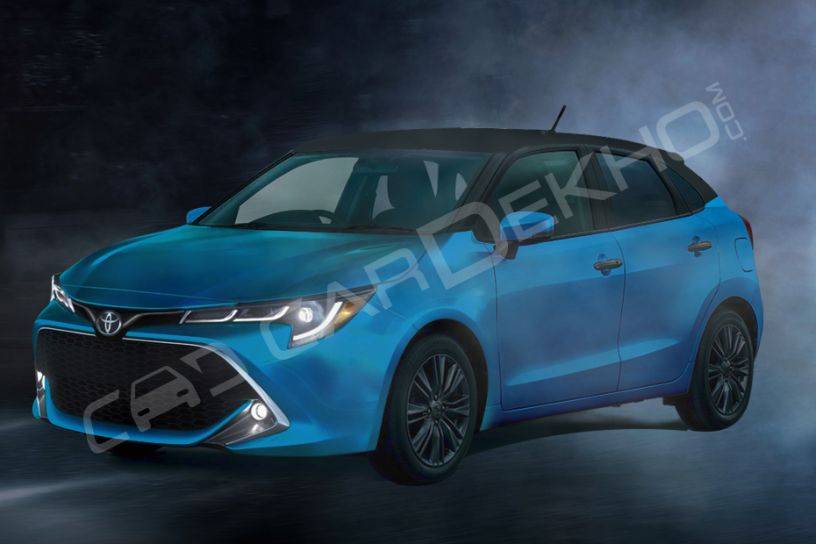Toyota's Version Of Maruti Baleno: What We Want
Modified On Apr 18, 2018 11:16 AM By Raunak
- Write a comment
While the Maruti Suzuki Baleno is already a well specced model, we hope Toyota’s version offers more safety kit and edgier styling

Rendering: Toyota Baleno (for representation purpose only)
India’s best-selling premium hatchback, the Maruti Suzuki Baleno, will be rebadged as a Toyota soon. After trying its luck with the Etios and the Etios Liva in the sub-Rs 10 lakh bracket, Toyota has decided to cash in on Suzuki’s expertise in the same by way of badge engineering.

Toyota and Suzuki have joined forces and will source select vehicles from each other purely for the Indian market. Under this agreement, one of the cars that Toyota will source from Suzuki is the Baleno, which is globally manufactured here in India.

Curious about what could be the final outcome? Well, here’s how we want Toyota’s version of the Maruti Baleno to shape up.
A striking exterior design

Pictured: Suzuki Heartect Platform
Would you go for Maggi noodles (a product of Nestle) wrapped in an ITC packaging? I wouldn’t. I mean there has to be some extra masala and zing if you’re practically selling the same product under different labels. And that too when the existing product is the most popular one in the market.

The Maruti Suzuki Baleno looks understated in front of rivals such as the Elite i20. Even the new Swift looks more striking than the Baleno with that wide grille. Toyota doesn’t make subtle cars like the Baleno; in fact, its cars are all about brawny grilles and edgier proportions. It has stopped making boring looking cars. I mean, just look at the C-HR compact SUV or the next-gen Corolla hatchback, the Auris, for example. These cars look sharp with a hard-to-ignore appearance, much like a Lexus.

Pictured: Toyota C-HR

Pictured: Toyota Auris Hybrid/Corolla Hatch
If I were to design Toyota’s version of the Baleno I would take inspiration from the new Auris, a hatchback based on the upcoming Corolla sedan which sits a segment above the Baleno globally. A wide and humongous grille along with a sculpted bonnet will make Toyota’s version tauter than the Baleno. Wraparound tail lamps and redesigned bumper would make the rear profile in line with the front.

Rendering: Toyota Baleno (for representation purpose only)
Toyota should also improve the rear stance of the Baleno as it looks unnecessarily raised up. Machine-cut wheels and a dual-tone paint finish would wrap up the rebadged Maruti Suzuki Baleno in my books.

Pictured: Toyota Auris Hybrid/Corolla Hatch
Interior and features

The interior of the Baleno looks good and features an all-black theme as you get with the majority of cars in the segment. Toyota should carry forward the same with new upholstery, a leather one like the upcoming Yaris. The Baleno is a feature-loaded car and Toyota’s version should carry forward its equipment list with goodies such as a 7-inch infotainment system with Apple Carplay and Android Auto, auto LED headlamps (expected in the Baleno facelift), auto climate control and auto-dimming IRVM.

Pictured: Suzuki Baleno (Australia-spec)
Where Toyota should work on is the safety aspect of the Baleno. Safety should be the core differentiator for Toyota’s version of the Baleno like its siblings. The Yaris, for instance, gets seven airbags as standard! Like the Etios family, it should get three standard adjustable rear headrests and 3-point seatbelts for all three passengers at the rear. The range-topping model should at least pack six airbags like its arch rival, the Hyundai Elite i20. You would be surprised to know that all of these things are offered in the Euro-spec Baleno, which is exported from here.

Pictured: Suzuki Baleno (Australia-spec)
2018 Hyundai Elite i20 Facelift: 5 Things That Could Have Been Better
Mechanicals: A TRD Sportivo version with the 1.0-litre Boosterjet
Like the majority of badge engineered cars, the Toyota’s Baleno-based premium hatchback will carry forward the Maruti’s existing set of engines: 1.2-litre petrol and 1.3-litre diesel. However, the Baleno might ditch the current Fiat-borrowed diesel as Maruti is reportedly planning to introduce an inhouse-developed 1.5-litre diesel soon. Offering the same set of engines saves time as well as development cost for Toyota.

While that was all expected and boring stuff, the interesting bit is the TRD Sportivo version of the Toyota’s hatch based on the Baleno RS! Toyota offers sporty-looking TRD offerings of its cars and with the RS’ powerful 1.0-litre turbocharged boosterjet engine, the Toyota hatch would go fast as well! Though the Baleno RS lacks the desirability quotient over the regular model in terms of appearance, Toyota’s TRD version should look better with chunkier spoiler and body add-ons similar to other TRD models.

Pictured: Toyota Corolla Hatch XSE
Expected launch and prices
At this point in time, there’s no clarity on the arrival of the rebadged cars from Toyota and Suzuki. It could next year or in 2020, when the BSVI emission norms are implemented in the country from April.
Toyota usually prices its cars at a slight premium over their rivals. The Baleno, for instance, is priced in the range of Rs 5.35 lakh - 8.49 lakh (ex-showroom, New Delhi). The Toyota hatch could be priced between Rs 6-9 lakh. At that price, we think the premium over the Baleno would be justifiable if Toyota offers what we expect from its first-ever premium hatchback in the Indian market.
Don't Miss: Toyota's Version Of Maruti Vitara Brezza - What We Want















